Subway has had an amazing success story. The sandwich concept has grown from a single unit in Connecticut run by a teenager into the world’s largest restaurant chain by unit count.
Subway’s growth has seemed unstoppable. The brand is literally everywhere: in malls, on street corners, in hospitals and universities, inside suburban community centers, and even in churches. For a time, a Subway outlet on a crane fed workers building the World Trade Center in New York.
But this week, as Subway lost spokesman Jared Fogle in the worst way possible, focus has shifted toward whether Subway has expanded too much. Its ubiquity might not be such a good thing anymore.
“It’s really been a victim of its own success,” David Henkes, vice president at Chicago-based consulting firm Technomic, told Bloomberg television. “It’s really saturated the market. It’s got over 27,000 locations now. The unit economics are very tough. Competitors have really come in and provided some alternatives to consumers that have caused Subway to suffer some sales losses.”
In 1998, the year before Jared Fogle became famous for losing 245 pounds by eating Subway sandwiches and exercising, Subway had 11,540 locations, according to Nation’s Restaurant News Top 100 data. It was less than 1,000 units smaller than McDonald’s Corp., which was at the time the biggest restaurant chain in the nation based on unit count.
Last year, Subway had 26,530 locations. McDonald’s has 14,350 units.

Worldwide, Subway has 44,000 restaurants. And it plans to keep rolling: Executives have suggested that it could reach 100,000 locations.
But its high unit count comes at a cost. Each unit does small volumes. An average Subway location does $464,000 a year in sales, based on NRN Top 100 estimates. Subway is one of only seven restaurant chains among the 100 largest concepts that have unit volumes below $600,000.
Plus, its unit volumes have been dropping, falling 1.5 percent last year. The year before, they fell 2.3 percent, marking a 3.8-percent decline in two years.
Subway still added another 200 locations in the U.S. this year, even as sales have faltered.
“Subway’s business has been selling franchises,” Darren Tristano, an executive vice president at Technomic, told Bloomberg. “If your goal is to have the most versus the best, you’ll eventually run into trouble.”
Additionally, competition is much tougher than it has been in a while. Other sandwich chains, like Jimmy John’s, have grown quickly and taken business by adding strategies such as delivery. Chipotle Mexican Grill, meanwhile, took Subway’s innovative assembly line strategy and has been so successful that many in the restaurant industry wrongly call it “the Chipotle model” instead of “the Subway model.”
Subway’s rapid expansion has made it difficult to build sales. As Henkes noted on Bloomberg TV, Subway’s low unit volume means that existing operators have to own multiple locations to make a decent living. Indeed, 80 percent of the 360 locations Subway is expected to open in North America this year are expected to go to existing operators.
That results in encroachment on existing locations. If two Subway units are located near each other, that makes it difficult for both of them to build additional sales because they both take business from the same territory.
“The economics get very challenging for a franchisee,” Henkes told Bloomberg.

To be sure, Subway faces other challenges. One of them might be the definition of what the public considers “healthy.” For years, its marketing campaign with Fogle gave Subway a healthful halo that is rare for a quick-service chain.
While it still has that halo, consumers have become increasingly concerned about gluten and carbs. Subway’s bread is thick and loaded with both.
“This perception of a mouthful of bread is potent,” restaurant consultant John Gordon told Nation’s Restaurant News. “Everybody is talking about carbs and the like, and I don’t believe they developed much of a carb approach.”
Subway still has to find ways to build sales at existing units. It has tried by adding breakfast to its locations, although that hasn’t lifted unit volumes. As Henkes said, Subway needs to “make individual units and franchisees healthy enough that they can grow same-store sales instead of just adding units every year.”
But Subway still has a massive ad budget, a big name and the ability to pull out of its weakness, NRN reported earlier this week. All chains struggle at some point. After all, Subway made Jared Fogle a household name in the first place. It has also made $5 a target price in quick service, with its $5 Footlong promotion. Subway can find something else that works and rebuild sales.
Contact Jonathan Maze at [email protected]
Follow him on Twitter: @jonathanmaze





